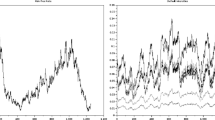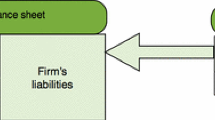Abstract
This paper studies an optimal investment and risk control problem for an insurer with default contagion and regime-switching. The insurer in our model allocates his/her wealth across multi-name defaultable stocks and a riskless bond under regime-switching risk. Default events have an impact on the distress state of the surviving stocks in the portfolio. The aim of the insurer is to maximize the expected utility of the terminal wealth by selecting optimal investment and risk control strategies. We characterize the optimal trading strategy of defaultable stocks and risk control for the insurer. By developing a truncation technique, we analyze the existence and uniqueness of global (classical) solutions to the recursive HJB system. We prove the verification theorem based on the (classical) solutions of the recursive HJB system.





Similar content being viewed by others
References
Andruszkiewicz, G., Davis, H.A., LIeo, S.: Risk-sensitive investment in a finite-factor model. Stochastics 89, 89–114 (2016)
Birge, J., Bo, L., Capponi, A.: Risk-sensitive asset management and cascading defaults. Math. Oper. Res. 43, 1–28 (2018)
Bo, L., Wang, S.: Optimal investment and risk control for an insurer with stochastic factor. Oper. Res. Lett. 45, 259–265 (2017)
Carr, P., Wu, L.: Stock options and credit default swaps: a joint framework for valuation and estimation. J. Financ. Econ. 8, 409–449 (2010)
Carr, P., Linetsky, V.: A jump to default extended CEV model: an application of Bessel processes. Financ. Stoch. 10, 303–330 (2006)
Campbell, J., Taksler, G.: Equity volatility and corporate bond yields. J. Financ. 63, 2321–2349 (2003)
Capponi, A., Figueroa Lopez, J.E.: Dynamic portfolio optimization with a defaultable security and regime-switching markets. Math. Financ. 24, 207–249 (2014)
Capponi, A., Figueroa Lopez, J.E., Nisen, J.: Pricing and semi-martingale representations of vulnerable contingent claims in regime-switching markets. Math. Financ. 24, 250–288 (2014)
Elliott, R.J., Siu, T.K.: Robust optimal portfolio choice under Markovian regime-switching model. Meth. Comput. Appl. Probab. 11, 145–157 (2009)
Elliott, R.J., Siu, T.K., Chan, L., Lau, J.W.: Pricing options under a generalized Markov-modulated jump-diffusion model. Stoch. Anal. Appl. 25, 821–843 (2007)
Frey, R., Backhaus, J.: Pricing and hedging of portfolio credit derivatives with interacting default intensities. Int. J. Theor. Appl. Financ. 11, 611–634 (2008)
Jiao, Y., Kharroubi, I., Pham, H.: Optimal investment under multiple defaults risk: a BSDE-decomposition approach. Ann. Appl. Probab. 23, 455–491 (2013)
Jones, P.M.: Trade Credit Insurance, p. 15. Primer Series on Insurance, Issue (2010)
Mendoza-Arriaga, R., Linetsky, V.: Multivariate subordination of Markov processes with financial applications. Math. Financ. 26, 699–747 (2016)
Merton, R.: Lifetime portfolio selection under uncertainty: the continuous-time case. Rev. Econom. Stats. 51, 247–257 (1969)
Merton, R.: Optimum consumption and portfolio rules in a continuous-time model. J. Econ. Theory 3, 373–413 (1971)
Peng, X., Wang, W.: Optimal investment and risk control for an insurer under inside information. Insur. Math. Econom. 69, 104–116 (2016)
Shen, Y., Siu, T.K.: Consumption-portfolio optimization and filtering in a hidden Markov-modulated asset price model. J. Ind. Manag. Optim. 12, 23–46 (2016)
Smith, H.L.: Monotone Dynamical Systems: An Introduction to the Theory of Competitive and Cooperative Systems. Mathematical Surveys and Monographs. AMS, Providence (2008)
Zhang, Q., Zhou, X.Y.: Valuation of stock loans with regime switching. SIAM J. Control Optim. 48, 1229–1250 (2009)
Zhou, X.Y., Yin, G.: Markowitz’s mean-variance portfolio selection with regime switching: a continuous-time model. SIAM J. Control Optim. 42, 1466–1482 (2003)
Zou, B., Cadenillas, A.: Optimal investment and risk control policies for an insurer: expected utility maximization. Insurance: Math. Econom. 58, 57–67 (2014)
Zou, B., Cadenillas, A.: Optimal investment and liability ratio policies in a multidimensional regime switching model. Risk 5, 1–22 (2017)
Acknowledgements
The authors gratefully acknowledge the constructive and insightful comments provided by one anonymous reviewer and Editor-in-Chief, Prof. Ulrich Horst, which helped to greatly improve the quality of the manuscript. This research of L. Bo and H. Liao was supported in part by the NSF of China under Grant 11471254, The Key Research Program of Frontier Sciences, CAS under Grant QYZDB-SSW-SYS009, and Fundamental Research Funds for Central Universities under Grant WK3470000008.
Author information
Authors and Affiliations
Corresponding author
Technical proofs
Technical proofs
Proof of Lemma 4.1
Define \(f(x)=Bx\) for \(x\in \mathbb {R}^m\). By virtue of Proposition 1.1 of Charter 3 in Smith [19], it suffices to verify that \(f:\mathbb {R}^m\rightarrow \mathbb {R}^m\) is of type K, i.e., for any \(x,y\in \mathbb {R}^m\) satisfying \(x\le y\) and \(x_i=y_i\) for some \(i=1,\ldots ,m\), then \(f_i(x)\le f_i(y)\). Notice that \(b_{ij}\ge 0\) for all \(i\ne j\). Then, it holds that
and hence f is of type K. Thus, we complete the proof of the lemma. \(\square \)
Proof of Lemma 4.2
The expression of the solution \(\varphi (t,e_n)\) given by (24) is obvious. Notice that \(e_m\gg 0\) and \(q_{ij}\ge 0\) for all \(i\ne j\) since \(Q=(q_{ij})_{m\times m}\) is the generator of the Markov chain. Then, in order to prove \(\varphi (t,e_n)\gg 0\) for all \(t\in [0,T]\), using Lemma 4.1, it suffices to verify \([A^{(n)}]_{ij}\ge 0\) for all \(i\ne j\), however, \([A^{(n)}]_{ij}=q_{ij}\) for all \(i\ne j\) using (21). Thus, we have verified the condition given in Lemma 4.1, and hence \(\varphi (t,e_n)\gg 0\) for all \(t\in [0,T]\). \(\square \)
Proof of Lemma 4.3
It suffices to prove that, for any \(x,y\in \mathbb {R}^m\) satisfying \(x,y\ge \varepsilon e_m^{\top }\) with \(\varepsilon >0\), there exists a constant \(C=C(\varepsilon )>0\) depending on \(\varepsilon >0\) only such that \(|G_i^{(k)}(t,x)-G_i^{(k)}(t,y)|\le C\Vert x-y\Vert \) for each \(i=1,\ldots ,m\). Since \(\sigma (i)\sigma (i)^{\top }\) is also positive definite, \(\sigma ^{(k)}(i)\sigma ^{(k)}(i)^{\top }\) is positive definite. Hence, there exists a constant \(\delta >0\) such that \((\pi ^{(k)})^{\top }\sigma ^{(k)}(i)\sigma ^{(k)}(i)^{\top }\pi ^{(k)}\ge \delta \Vert \pi ^{(k)}\Vert ^2\). Then, for any \((\pi ^{(k)},l)\in \mathcal{U}^{(k)}\), there exists a positive constant \(C_1>0\) such that
where the constant \(\alpha \in (\max _{i=1,\ldots ,m}\big \{\frac{\Vert \phi (i)\Vert ^2}{\bar{\phi }(i)\bar{\phi }(i)^{\top }+\Vert \phi (i)\Vert ^2}\big \},1)\). On the other hand, for any \((\pi ^{(k)},l)\in {{\mathcal {U}}}^{(k)}\), it holds that
where the constant \(C_2:=\max _{i=1,\ldots ,m}\big \{\gamma \sqrt{\Vert \theta ^{(k)}(i)\Vert ^2+|p^{(k)}(i)-c(i)|^2}\big \}>0\). Finally, for any \((\pi ^{(k)},l)\in {{\mathcal {U}}}^{(k)}\), we have that \(\{(1-lg(i))^\gamma -1\}\nu ^{(k)}(i)\le C_3l\), where the constant \(C_3:=\max _{i=1,\ldots ,m}\{\gamma g(i)\nu ^{(k)}(i)\}>0\). Then, by virtue of (29), it follows that, for any \((\pi ^{(k)},l)\in {{\mathcal {U}}}^{(k)}\) and \(i=1,\ldots ,m\),
Here \(C_4=C_2+C_3\). This yields that there exists a constant \(C_5>0\) such that when \((\pi ^{(k)},l)\in {{\mathcal {U}}}^{(k)}\) and \(\Vert \pi ^{(k)}\Vert ^2+l^2>C_5\), we have \(H^{(k)}((\pi ^{(k)},l),i)<0\) for all \(i=1,\ldots ,m\), and meanwhile, for \(x\ge \varepsilon e_{m}^{\top }\) with \(\varepsilon >0\),
for some constants \(C_6,C_7,C_8>0\). Notice that we used the recursive assumption that the HJB system (18) admits a positive unique (classical) solution \(\varphi ^{(k+1),j}(t)\) on \(t\in [0,T]\) for \(j\notin \{j_1,\ldots ,j_k\}\). Then \(\varphi ^{(k+1),j}(t)\) is continuous on [0, T], and hence \(\varphi ^{(k+1),j}(t)\) is bounded on [0, T]. From the estimate (A.5), it follows that, for any \(x\ge \varepsilon e_m^{\top }\), there exists a positive constant \(C_9=C_9(\varepsilon )\) such that when \((\pi ^{(k)},l)\in {{\mathcal {U}}}^{(k)}\), \(\Vert \pi ^{(k)}\Vert ^2+l^2>C_9\) and \(x\ge \varepsilon e_m^{\top }\), it holds that, for each \(i=1,\ldots ,m\),
On the other hand, for \(i=1,\ldots ,m\), it holds that
Thus, using the estimate (A.6), we have that, for all \(x\ge \varepsilon e_m^{\top }\),
It follows from (A.8) and (29) that, for all \(x,y\ge \varepsilon e_m^{\top }\),
where \(C(\varepsilon )>0\) is a constant which depends on \(\varepsilon >0\) only. Then, the above estimate results in the validity of the estimate (30) for all \(x,y\in \mathbb {R}^m\) satisfying \(x,y\ge \varepsilon e_m^{\top }\). Thus, we complete the proof of the lemma. \(\square \)
Proof of Lemma 4.4
For \(p>0\), let \(g_{1}^{(p)}(t)=(g_{1i}^{(p)}(t);\ i=1,\ldots ,m)^{\top }\) be the solution to the following dynamical system given by
Then, for all \(t\in (0,T]\), it holds that
Here \(C>0\) (resp. \(\tilde{C}>0\)) is the Lipschitz constant of f(t, x) (resp. \(\tilde{f}(t,x)\)) in x. Then, the Gronwall’s lemma yields that \(g_{1}^{(p)}(t)\rightarrow g_1(t)\) for all \(t\in [0,T]\) as \(p\rightarrow \infty \). We claim that \(g_{1}^{(p)}(t)\gg g_2(t)\) for all \(t\in [0,T]\). If the claim were false, notice that \(g_{1}^{(p)}(0)\gg g_2(0)\), and \(g_1^{(p)}(t),g_2(t)\) are continuous on [0, T], then there exists a \(t_0\in (0,T]\) such that \(g_{1}^{(p)}(s)\ge g_2(s)\) on \(s\in [0,t_0]\) and \(g_{1i}^{(p)}(t_0)=g_{2i}(t_0)\) for some \(i\in \{1,\ldots ,m\}\). Since \(t_0>0\), \(g_1^{(p)}(t)\) and \(g_2(t)\) are differentiable on (0, T], we have that
On the other hand, since \(f(t,\cdot )\) satisfies the type K condition for each \(t\in [0,T]\) and \(\tilde{f}(t,x)\ge 0\) for all \((t,x)\in [0,T]\times \mathbb {R}^m\), for the above i, we also have that
This results in a contradiction, and hence \(g_{1}^{(p)}(t)\gg g_2(t)\) for all \(t\in [0,T]\). Thus, it holds that \(g_1(t)\ge g_2(t)\) for all \(t\in [0,T]\) by letting p tend to infinity. \(\square \)
Proof of Theorem 4.6
For \((t,x,i,z)\in [0,T]\times \mathbb {R}_+\times \{1,\ldots ,m\}\times {{\mathcal {S}}}\), note that \(\varphi (T,i,z)=\frac{1}{\gamma }\). Then, by virtue of Itô’s formula, for all \((\pi ,l)\in \tilde{{\mathcal {U}}}\), it follows that
Here for \((\pi ,l)\in (-\infty ,1]^n\times [0,\infty )\) and \((t,i,z)\in [0,T]\times \{1,\ldots ,m\}\times {{\mathcal {S}}}\), the coefficient is given by
and the \( \mathbb {P} \)-(local) martingale is defined as
where we used the following \( \mathbb {P} \)-martingale processes given by, for \(t\in [0,T]\),
for all \(i,j\in \{1,\ldots ,m\}\) and \(i\ne j\). Here, we recall that the process \(H_{ij}(t)\) is defined by (15). Using (18), (23) and (38), for \(t\in [0,T]\times \{1,\ldots ,m\}\times {{\mathcal {S}}}\), we have that \(\mathcal{A}(\pi ,l;t,i,z)\le {{\mathcal {A}}}(\pi ^*,l^*;t,i,z)=0\) for all \((\pi ,l)\in {{\mathcal {U}}}\). Moreover, define \(\tau _a:=\inf \{s\ge t;\ |X^{\pi ,l}(s)|>a\}\) for \(a>0\). Eq. (12) gives that, for \(s\in [t,T]\),
where the feedback controls are given by
Notice that \((\pi ,l)\in {{\mathcal {U}}}\) is locally bounded, and hence
The positive constant \(C_1\) depends on \((\pi ,l)\), a and T only. Since \(|\Delta M|\vee |\Delta N|\le 1\), it follows that
where \(C_2\) is a positive constant which depends on \((\pi ,l)\), a and T only. This implies that \(M^{\pi ,l}(\cdot \wedge \tau _a)\) is a \( \mathbb {P} \)-martingale. Hence, it holds that
where we set \( \mathbb {E} _{t,i,z}[\cdot ]:= \mathbb {E} [\cdot \mid X^{\pi ,l}(t)=x,Y(t)=i,Z(t)=z]\) for \((t,x,i,z)\in [0,T]\times \mathbb {R}_+\times \{1,\ldots ,m\}\times {{\mathcal {S}}}\). It follows from Fatou’s lemma that
This verifies the validity of the conclusion (i).
We next prove the conclusion (ii). In fact, recall that the optimal feedback strategy \((\pi ^{*},l^*)=(\pi ^*(t,i,z),l^*(t,i,z))\) for \(i=1,\ldots ,m\) is given by (23) for \(k=n\) and given by (38) for \(k=0,1,\ldots ,n-1\). Then, there exists a constant \(C>0\) which is independent of (t, i, z) such that \(\Vert \pi ^*(t,i,z)\Vert ^2+|l^*(t,i,z)|^{2}\le C\) for all \((t,i,z)\in [0,T]\times \{1,\ldots ,m\}\times {{\mathcal {S}}}\). We next estimate \( \mathbb {E} [(X^{\pi ^*,l^*}(T\wedge \tau _a))^{2\gamma }]\). First of all, the dynamics of the wealth process can be rewritten as, for \(s\in [t,T]\),
Then, Itô’s formula yields that for \(u\in [t,T]\),
Here, for \((\pi ,l)\in (-\infty ,1]^n\times [0,\infty )\) and \((i,z)\in \{1,\ldots ,m\}\times {{\mathcal {S}}}\),
The \( \mathbb {P} \)-(local) martingale is given by, for \(t\in [0,T]\),
As above, we have that \(\Vert \pi ^*(t,i,z)\Vert ^2+|l^*(t,i,z)|^{2}\le C\) for all \((t,i,z)\in [0,T]\times \{1,\ldots ,m\}\times {{\mathcal {S}}}\), and hence
Then, there exists a constant \(C>0\) such that for all \((t,i,z)\in [0,T]\times \{1,\ldots ,m\}\times {{\mathcal {S}}}\),
Thus, we have that for all \(t\in [0,T]\),
The Gronwall’s inequality yields that
and hence \(\{(X^{\pi ^*,l^*}(T\wedge \tau _a))^{\gamma }\}_{a\in \mathbb {R}_+}\) is uniformly integrable. This yields that
This verifies the validity of the conclusion (ii). \(\square \)
Rights and permissions
About this article
Cite this article
Bo, L., Liao, H. & Wang, Y. Optimal credit investment and risk control for an insurer with regime-switching. Math Finan Econ 13, 147–172 (2019). https://doi.org/10.1007/s11579-018-0222-7
Received:
Accepted:
Published:
Issue Date:
DOI: https://doi.org/10.1007/s11579-018-0222-7




